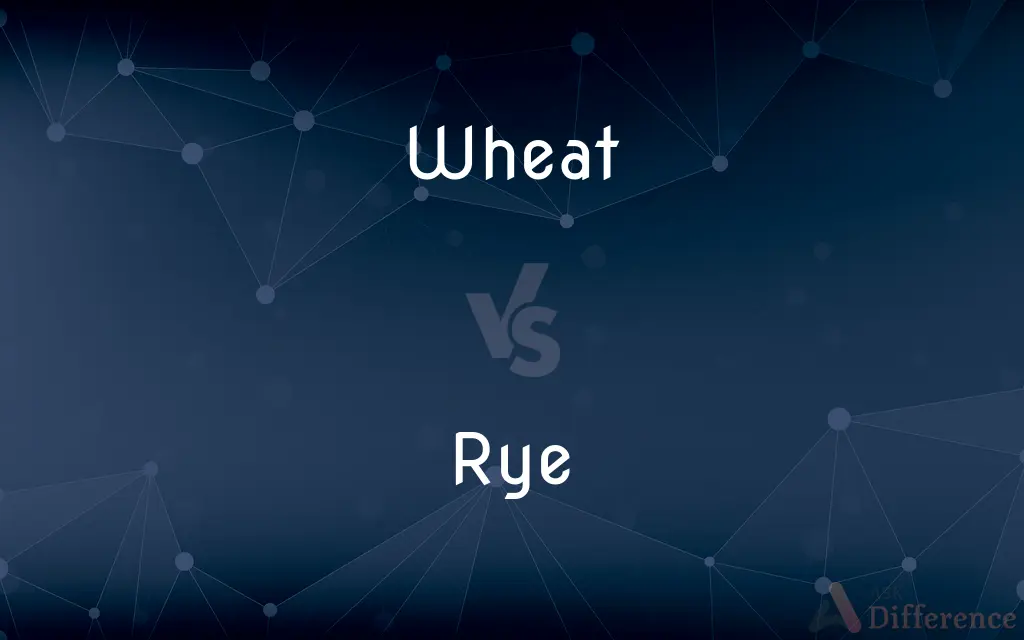Wheat vs. Rye — What's the Difference?
By Tayyaba Rehman — Updated on September 23, 2023
Wheat is a cereal grain known for its golden kernels, primarily used for bread and pasta, while rye is a hardy grain with darker kernels, often used for rye bread and certain whiskies.

Difference Between Wheat and Rye
Table of Contents
ADVERTISEMENT
Key Differences
Wheat is one of the world's most widely consumed grains, known for its golden-colored kernels. Its high gluten content makes it ideal for producing a variety of baked goods. Rye, however, is a distinct grain with a more robust flavor and darker-colored kernels, and it grows well in cooler climates.
In terms of nutrition, both wheat and rye offer essential nutrients. While wheat is rich in dietary fiber, proteins, and various vitamins, rye is known for its even higher fiber content and several health benefits, including improved blood sugar control.
The applications of these grains differ significantly. Wheat is a dominant ingredient in many foods, from bread, pastries, and noodles to cereals. Rye is typically found in rye bread, rye beer, and certain whiskies, giving these products their unique taste and texture.
Lastly, while both wheat and rye are staple crops and have been cultivated for millennia, wheat holds a more prominent place in many cultures due to its versatility and widespread cultivation. In contrast, rye is more region-specific, particularly popular in parts of Europe.
Comparison Chart
Appearance
Golden-colored kernels.
Darker-colored kernels.
ADVERTISEMENT
Climate Preference
Prefers warmer climates.
Thrives in cooler climates.
Uses
Bread, pasta, cereals, pastries.
Rye bread, rye beer, certain whiskies.
Nutritional Content
High in fiber, protein, and vitamins.
Higher in fiber, beneficial for blood sugar control.
Cultural Significance
Widespread consumption globally.
More popular in specific regions, especially in Europe.
Compare with Definitions
Wheat
A globally consumed cereal grain.
Wheat fields stretch across the plains, ready for harvest.
Rye
A grain with robust flavor and darker kernels.
The rye fields gave the landscape a deep green hue.
Wheat
Known for its golden-colored kernels.
The bright hue of the wheat glistened under the sun.
Rye
Known for thriving in cooler climates.
The northern regions are suitable for rye cultivation.
Wheat
A significant source of dietary fiber and protein.
Including wheat in your diet can provide essential nutrients.
Rye
Offers numerous health benefits.
Consuming rye can help maintain steady blood sugar levels.
Wheat
A primary ingredient in many baked goods.
Freshly baked wheat bread has a comforting aroma.
Rye
A grain with significant cultural importance in Europe.
Rye beers are popular in some European countries.
Wheat
Often ground into flour for culinary use.
She bought a bag of whole wheat flour for baking.
Rye
Commonly used for rye bread and certain whiskies.
He enjoyed a slice of rye bread with his soup.
Wheat
Wheat is a grass widely cultivated for its seed, a cereal grain which is a worldwide staple food. The many species of wheat together make up the genus Triticum; the most widely grown is common wheat (T. aestivum).
Rye
Rye (Secale cereale) is a grass grown extensively as a grain, a cover crop and a forage crop. It is a member of the wheat tribe (Triticeae) and is closely related to both wheat (Triticum) and barley (genus Hordeum).
Wheat
A cereal which is the most important kind grown in temperate countries, the grain of which is ground to make flour for bread, pasta, pastry, etc.
Rye
A cereal grass (Secale cereale) of cool climates, widely cultivated for its grain.
Wheat
Any of various annual cereal grasses of the genus Triticum of the Mediterranean region and southwest Asia, especially T. aestivum, widely cultivated in temperate regions in many varieties for its commercially important edible grain.
Rye
The grain of this plant, ground into flour or used in making whiskey and for livestock feed.
Wheat
The grain of any of these grasses, ground to produce flour used in breads, pasta, and other foods.
Rye
Rye bread.
Wheat
(countable) Any of several cereal grains, of the genus Triticum, that yields flour as used in bakery.
Rye
Whiskey made from the grains of this plant.
Wheat
(uncountable) A light brown colour, like that of wheat.
Rye
A Romani man.
Wheat
Wheaten, of a light brown colour, like that of wheat.
Rye
A grain used extensively in Europe for making bread, beer, and (now generally) for animal fodder.
Wheat
A cereal grass (Triticum vulgare) and its grain, which furnishes a white flour for bread, and, next to rice, is the grain most largely used by the human race.
Rye
The grass Secale cereale from which the grain is obtained.
Wheat
Annual or biennial grass having erect flower spikes and light brown grains
Rye
Rye bread.
Wheat
Grains of common wheat; sometimes cooked whole or cracked as cereal; usually ground into flour
Rye
Rye whiskey.
Rye
A drink of rye.
Rye
Caraway (from the mistaken assumption that the whole seeds, often used to season rye bread, are the rye itself)
Rye
Ryegrass, any of the species of Lolium.
Rye
A disease of hawks.
Rye
A grain yielded by a hardy cereal grass (Secale cereale), closely allied to wheat; also, the plant itself. Rye constitutes a large portion of the breadstuff used by man.
Rye
A disease in a hawk.
Rye
The seed of the cereal grass
Rye
Hardy annual cereal grass widely cultivated in northern Europe where its grain is the chief ingredient of black bread and in North America for forage and soil improvement
Rye
Whiskey distilled from rye or rye and malt
Common Curiosities
Why is rye bread darker?
Rye has darker kernels and a robust flavor, influencing the bread's color and taste.
Do wheat and rye have gluten?
Yes, both grains contain gluten, though rye has less than wheat.
Can I substitute rye for wheat in recipes?
You can, but it will alter the flavor, texture, and may require recipe adjustments.
Are there different types of wheat?
Yes, including hard red, soft red, durum, and more, each with distinct uses.
Is wheat more common than rye?
Yes, wheat is more widely cultivated and consumed than rye globally.
Which grain is better for cooler climates?
Rye thrives better in cooler climates compared to wheat.
Can people with gluten intolerance eat rye?
No, rye contains gluten, which can trigger reactions in those with gluten intolerance.
Why is rye used in some whiskies?
Rye imparts a spicy and complex flavor profile to whiskies.
Are there any allergenic concerns with wheat or rye?
Some people are allergic to wheat, and both grains contain gluten, affecting those with gluten-related disorders.
Which grain has a stronger flavor?
Rye has a more robust and distinct flavor compared to wheat.
How do the nutritional profiles of wheat and rye compare?
Both are nutritious; however, rye is particularly high in fiber.
What is the texture difference in wheat vs. rye bread?
Rye bread is denser and more compact, while wheat bread is generally softer.
Which grain is more versatile in cooking?
Wheat is more versatile, used in a broader range of dishes, from bread to pastries to noodles.
Why is wheat flour more common in baking?
Wheat's high gluten content gives elasticity and structure to baked goods.
What are the health benefits of rye?
Rye can aid digestion, provide essential nutrients, and help regulate blood sugar.
Share Your Discovery

Previous Comparison
Arial vs. Helvetica
Next Comparison
Valency vs. CovalencyAuthor Spotlight
Written by
Tayyaba RehmanTayyaba Rehman is a distinguished writer, currently serving as a primary contributor to askdifference.com. As a researcher in semantics and etymology, Tayyaba's passion for the complexity of languages and their distinctions has found a perfect home on the platform. Tayyaba delves into the intricacies of language, distinguishing between commonly confused words and phrases, thereby providing clarity for readers worldwide.














































